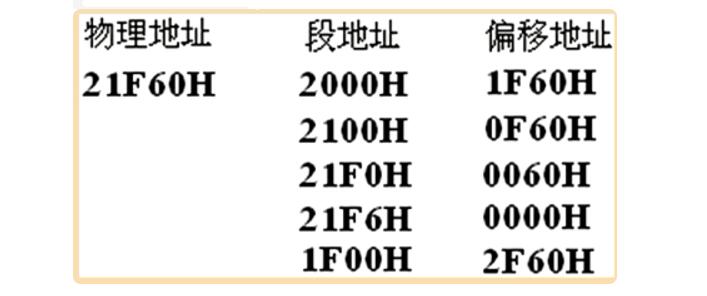What is the offset address _ offset address how to calculate
The offset address is the offset of an address in the segment relative to the first segment address (segment address) after the memory segmentation in the computer. The offset address is also called the offset. Since the ALU inside the 8086/8088CPU can only perform 16-bit operations, the 8086/8088 has 20 address lines and the direct address capability is 1MB. Therefore, the 20-bit physical address used by the 8086/8088 is composed of the corresponding segment address plus the offset address.

The 8086/8088 has 20 address lines and its direct addressing capability is 1MB. That is, there can be up to 1 MB of memory in a system with addresses from 00000H to FFFFFH. Given any 20-bit physical address, you can retrieve the required instructions and operands from it. However, the 8086/8088 CPU can only perform 16-bit operations. The address-related registers SP, IP, BP, SI, and DI are also 16-bit, so the address operation can only be 16-bit. For the 8086/8088, regardless of which addressing method is used, the maximum range for seeking operands is 2^16, which is 64K. How can we form a 20-bit physical address? The system first divides the 1MB memory into 64KB ranges into several segments. When addressing a specific physical address, a 20-bit physical address is formed from a base address plus a 16-bit offset that can be handled by the CPU such as SP or IP.
When the system needs to generate a 20-bit address, a segment register is automatically selected. It automatically shifts left by 4 bits and adds a 16-bit address offset to generate the desired 20-bit address.
For example: the data segment DS register value = 0088H
Offset address = 22H
Then the generated 20-bit physical address is equal to 00880H + 22H = 008A2H

Left shift 4 bits is a hexadecimal back zero.
Segment address = 1F00H, offset address = 1000H,
Line address=1F000h+1000H=20000H
Segment address = 1F00H, offset address = 1000H,
Line address=1F000h+1000H=20000H
Get the address offset of a C++ class member variableFrequently asked how to get the address offset of the member variables in the class, this should be a very curious problem for many beginners of C++. When I was at school, I also had this need. Forget what "odd program" was written at the time, anyway, you need to get the address offset of a class member variable.
In fact, this problem is very simple, if you understand the C + + class object memory distribution, this is not a problem at all. I gave him an example:
structA
{
Inti;
};
&((A*)0)-"i;//This will get the offset. He said he did not understand, OK, let's talk specifically.
If we define variables Aa; we all know that &a denotes the first address of variable a, and (ai) denotes the address of variable i, then & (ai) minus &a does not get i's offset?
Yes, it is that simple. Then this example & ((A*)0)-"i; what's the relationship?
The address of & ((A*)0) is 0, so & ((A*)0)-"i is equal to & ((A*)0)-"i minus 0.
One netizen is more curious, why is &((A*)0)-"i not going wrong? This example does not allocate memory for A's object. How can I get its address?
Yes, there is really no memory allocated here, but in this example we didn't require memory and we don't operate on memory, so it won't lead to a crash.
&((A*)0)-"i just calculates its address for us using the compiler. When the compiler wants to use a member variable, it will get the address of the member variable based on the first address of the object plus the offset of the member. When the object's first address is 0, the resulting member variable address is its offset.
Fiber Optic Components,Parts Of Fiber Optic Cable,Fibre Optic Connector,Parts Of Optical Fiber
Cixi Dani Plastic Products Co.,Ltd , https://www.dani-fiber-optic.com